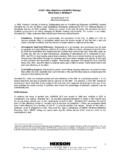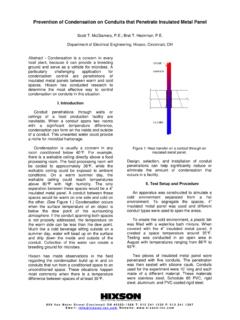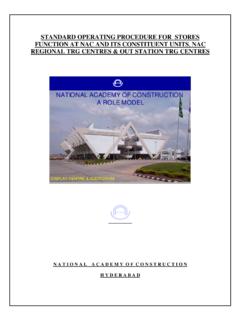Transcription of Combustible Dust Basics - Hixson Architecture, Engineering ...
1 Combustible dust Basics 659 Van Meter Street Cincinnati OH 45202-1568 T: F: Email: Website: Page 1 By Christopher A. Jarc, , PMP, LEED (with Contributions from The Hixson Baking Industry Team) Abstract From woodworking to metalworking, petrochemicals to fertilizers, any industry that can create or use fine powders as part of their processing must be concerned about the potential for combustion to occur. This is particularly true within the food processing industry, where starches, sugars, flavors, and other powdered substances are frequently used, often in large quantities. In recent years, several high-profile explosions caused by Combustible dust have created the need for greater awareness and oversight of processes involving the materials. Additionally, OSHA has increased enforcement of a National Emphasis Program (NEP) that focuses on Combustible dust in the work place.
2 This paper outlines: The factors associated with the combustion of Combustible dust . Applicable building, fire, and electrical codes and referenced standards. How the codes impact building and equipment design. Steps for mitigation where Combustible dust is present within a facility. Combustible dust Basics 659 Van Meter Street Cincinnati OH 45202-1568 T: F: Email: Website: Page 2 Determining Combustibility The National Fire Protection Association (NFPA) defines Combustible dust as a Combustible particulate solid that presents a fire or deflagration hazard when suspended in air, or some other oxidizing medium, over a range of concentrations, regardless of particle size or shape. Using this definition, almost any agricultural product dust has some potential to be classified as a Combustible dust . NFPA further defines Combustible dust as: Finely ground/finely divided organic or metal material typically 420 micrometers ( m) or smaller.
3 In fact, the finer the dust , the more explosive it can be. Particles that are at 420 m or smaller in diameter can pass through a No. 40 standard sieve. Able to cause an explosion when suspended in air and exposed to a sufficient source of ignition. The material Safety Data Sheet (MSDS) for each product should list whether the product is Combustible or not. Note that often products are not Combustible as a whole but the dust from the material may be. Given these criteria, the table on the following page identifies some of the food products/ingredients that have Combustible dusts. Table 1: Examples of Industry Materials where dust is Combustible Source: OSHA Combustible dust Bulletin Alfalfa Apple Beet root Carrageen Carrot Cocoa bean Cocoa powder Coconut shell Coffee dust Corn meal Corn starch Cotton Cottonseed Garlic powder Gluten Grass dust Green coffee Hops (malted)
4 Lemon peel dust Lemon pulp Linseed Locust bean gum Malt Oat flour Oat grain Olive pellets Onion powder Dehydrated Parsley Peach Peanut meal and skins Peat Potato Potato flour Potato starch Raw yucca seed Rice Rice flour Rice starch Rye flour Semolina Soybean Spice dust Sugar Sunflower Sunflower seed Tea Tobacco Tomato Walnut dust Wheat flour Wheat grain Wheat starch Xanthan gum Combustible dust Basics 659 Van Meter Street Cincinnati OH 45202-1568 T: F: Email: Website: Page 3 Figure 1: Combustible dust Pentagon The Combustible dust Pentagon A dust explosion is different than a fire.
5 To create a fire, three factors are required: Oxygen, fuel, and an ignition source. However, for a dust explosion to occur, two additional factors are needed: The dust must be dispersed at the correct concentration in the air, and it must also be confined in some sort of enclosure, , a silo, dust control filter, bin, conveyor, bucket elevator, or room. This is known as the " Combustible dust Pentagon." All five elements (oxygen, fuel, heat, dispersion, and confinement) must be present for a Combustible dust explosion to occur. If one is missing, it would be difficult to have a dust explosion occur. Photo: Environmental factors have a big impact on the chemistry of a dust explosion. High oxygen content, high air temperature (in the form of a spark or flame), and high air turbulence can increase the risk of a Combustible dust explosion.
6 Measuring Combustibility Some of the dusts listed in Table 1 are a bigger danger than others. There are three key indices used to quantify explosiveness: 1) Minimum Ignition Energy (MIE). The MIE is the smallest amount of heat or electrical energy that is needed to ignite a dust /air mixture. The smaller the value, the more volatile the dust is. There are a number of physical characteristics that influence a product's MIE: Chemical composition. Organics and metals have lower MIE. Particle size. The smaller the particle, the lower the MIE. Moisture content. The lower the moisture, the lower the MIE. Table 2 lists MIE s for some common food product dusts. Remember, the lower the MIE, the more volatile the product is. Table 2: Minimum Ignition for Some Food Products Product (dusts) MIE (millijoules) Corn 45-100 Wheat 50 -100 Oats >500 Barley 50 100 Soybeans 50 -100 Starch (rice) >30 Starch (wheat 10 30 Sugar <10 Combustible dust Basics 659 Van Meter Street Cincinnati OH 45202-1568 T: F: Email: Website: Page 4 Note that the MIE for any given product will be smaller as the dust particle gets smaller.
7 For example, a whole corn kernel has a high MIE; corn dust has a much lower MIE. 2) Minimum Explosion Concentration (MEC). Often called the Lower Explosive Limit (LEL), the MEC is the minimum concentration of Combustible dust suspended in air, measured in mass per unit volume that will support a deflagration (OSHA). Measured in oz. , MEC is dependent on the size of the particle, the temperature of the ignition source, and the amount of oxygen in the air. As a rule of thumb, a cloud density in which the visibility of a 25-watt light bulb is less than six feet is sufficient to create an explosion. The MEC is the measure of the dispersion factor in the Combustible dust Pentagon. If the amount of dust in the air per cubic foot is greater than the MEC, explosive conditions are present. 3) Deflagration Index (KSt). The deflagration index, measured in bar-meters per second, indicates how big an explosion would be by measuring the maximum rate of pressure rise for most favorable dust /air mixture to create an explosion.
8 In general, the larger the KSt value is, the more violent the explosion. The Kst value is used to size explosion deflagration venting and pressure relief apparatus. The higher the Kst value, the larger the deflagration vent area is needed. Two factors influence the deflagration index: chemical composition (organic, metals) and particle size (the smaller the particle, the higher the KSt). Due to this possible variation, the deflagration index values can vary by situation. Testing should be done on the exact material being processed to accurately determine its KSt. Table 3 lists some common organic and metal dust KSt values. Table 3: KSt Values for Organic and Metal Dusts dust type Kst Value Barley Grain 240 Rice Starch 190 Pectin 162 Soy Bean Flour 110 Milk Powder 90 Wood dust 102 Coal dust 85 Magnesium 508 Aluminum Powder 400 Primary and Secondary Explosions What makes a Combustible dust explosion more dangerous than a fire is how violent it is and how rapidly it can spread.
9 A fire will not spread without fuel: If no new fuel is available, the fire will die out. A Combustible dust explosion, however, can be self-perpetuating. When an explosion occurs, a heated shock wave is sent out in all directions. The shock wave will knock additional dust off of horizontal surfaces, causing it to be dispersed in the air. If the dust is at the right concentration, a secondary explosion will occur, causing further damage. The secondary explosion can cause a tertiary explosion, and so on. Secondary explosions generally cause more damage than the initial explosion because they cover more area. Combustible dust Basics 659 Van Meter Street Cincinnati OH 45202-1568 T: F: Email: Website: Page 5 Figure 2: Secondary explosions occur when a primary explosion in some piece of processing equipment dislodges or encounters fugitive dust that has accumulated and dispersed throughout the facility.
10 This fugitive dust , if ignited, causes additional explosions which actually can be more severe than the original explosion, due to increased concentrations and quantities of dispersed Combustible dust . Combustible dust Hazard and Applicable Codes Figure 3 shows the relationships between the building, fire and electrical codes as they apply to Combustible dust . NFPA standards apply for Combustible dust when referenced from any of the applicable codes. In addition, the Occupational Safety and Health Administration (OSHA) has released a National Emphasis Program (NEP) that is also currently enforced. The NEP generally follows building, fire and electrical codes, but has a few nuances that may alter the process and building design. The OSHA website contains the details on the Combustible dust NEP. Figure 3: The Relationship Between Various Codes and Standards and Combustible dust Combustible dust Basics 659 Van Meter Street Cincinnati OH 45202-1568 T: F: Email: Website: Page 6 Surprisingly, building and fire codes do not directly address Combustible dust .









